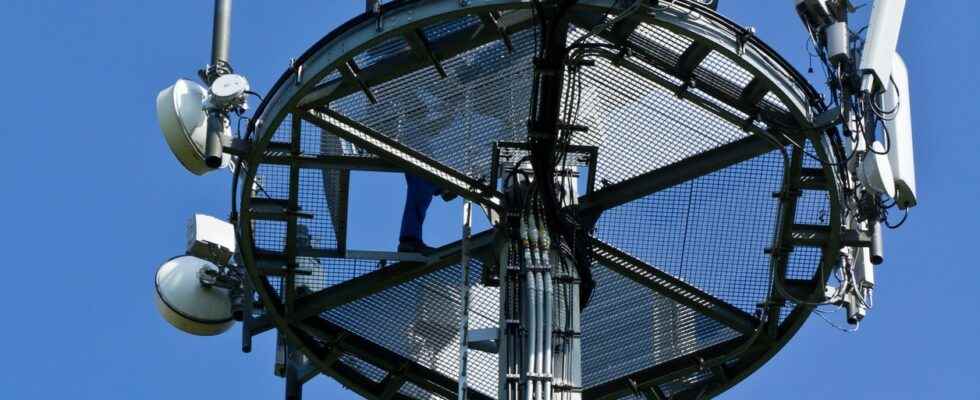The European Union has set a mission for all of its economic activities to achieve carbon neutrality by 2050. The international GSMA association, which represents the interests of mobile phone manufacturers, is committed , she, to accompany her sector in this way. It took advantage of the last edition of the MWC show in Barcelona a few weeks ago to publish a report on the circular economy of network equipment. A small cultural revolution for this market which sent its network equipment systematically to the dump until recently.
It must be said that the network part only represents between 2 and 14% of the digital environmental footprint in France, according to the joint study by Ademe and Arcep published in January 2022. If the only the global warming aspect is taken into account, the responsibility incumbent on the networks is even weaker. Less than 5% compared to nearly 80% for user terminals. This is mainly due to the volume of products sold around the world. The priority was therefore first to encourage users to extend the life of their smartphone. However, the manufacturing phase is the main source of carbon emissions from the networks. It therefore becomes absurd to focus only on their use and even often only on their energy consumption.
Reduce, reuse, recycle
The famous rule of the 3 “Rs” (Reduce, Reuse, Recycle) should therefore also apply to operators and their suppliers. Routers, modem switches, repeaters, servers, antennas, DSLAMs or OLTs are affected, for example. If efforts are made to collect them, 80% of the total would still end up being dismantled for lack of a candidate for reuse, points out the GSMA report. It is this second-hand market that needs to be improved immediately. But for the moment, the sector remains very fragmented and is struggling to match abundant supply with still weak demand.
Many operators are therefore launching their own initiatives. This is the case of Orange and its OSCAR program, for Orange Sustainable and Circular Ambition for Recertification. The operator now undertakes to buy second-hand. “We are starting to sign agreements with our suppliers such as Nokia, Ericsson or Juniper so that a share of the equipment is reconditioned when we launch calls for tenders”, explains Ramon Fernandez Orange. The idea is also to organize the resale of decommissioned equipment between the group’s subsidiaries. “We have set up internal platforms to recover equipment from one country to another”, he adds. When a 5G experiment ends, the equipment is sent to other sites or abroad.
Changing mindsets
However, there are limits to this strategy. The equipment manufacturer Nokia, which is fully committed to this circular economy approach, recognizes some obstacles. “When you are at the start of a new technology, renewal cycles are more frequent”, explains Thomas Bertrand, Director of the Western and Central European Market at Nokia. The company has already released its third generation 5G active antenna as the technology started rolling out just two years ago. “The client tends to go for the latest generation, but on some sites, we can very well use previous generations that we recycle”. It will therefore also be necessary to change mentalities and convince operators that refurbished equipment can be efficient to ensure the quality of the network.
For Huawei, there is another problem: not everything can be reused. “Take the example of microwave links at the end of their life after around ten years of use. This means that their design dates from 13 or 15 years ago, as well as their boards and their components. Can we really use them? », asks Jean-Christophe Tijoux, director of the Operators activity of Huawei France. In addition to technological obsolescence, equipment that remains outdoors, especially that of mobile networks, is sometimes exposed to frost, cold, heat and even extreme temperatures in some countries.
Also see video:
Eco-design and infrastructure sharing
The Chinese giant relies on the eco-design of its products to reduce its footprint from manufacturing. He started using non-mining and recycled metals like tin, gold and cobalt. And also identified a list of materials that he is trying to phase out. In particular, it has considerably reduced its use of copper in its products. This is the case of its OXC, a backplane that connects several printed circuit boards for fixed fiber optic networks. “Each board included a lot of electronics and cables. Everything has been replaced by small optical modules which, in addition, consume less »explains Jean-Christophe Tijoux.
There remains an additional lever for action: that of sharing infrastructures between operators. Not just pylons, but also active equipment. France is still cautious on the subject, because the question arises as to whether this would call into question competition between operators. Other countries are more voluntary in this regard, such as Belgium or Spain. The GSMA is therefore carrying out intensive lobbying so that the situation is clarified and harmonized at European level. Operators obviously have an interest in this to reduce their network costs and save money. But at the same time it would be a real step forward for the planet.
Sources: the GSMA Circular Economy Report, the Ademe/Arcep study on the environmental footprint of digital technology
